Click on images to enlarge

infestation (Photo: Sheldon Navie)
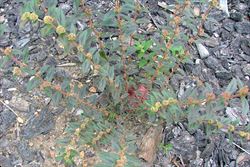
habit (Photo: Sheldon Navie)

habit growing in a lawn (Photo: Sheldon Navie)
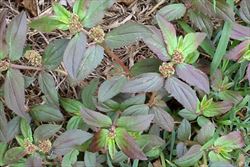
the leaves often have a reddish or purplish tinge, especially when growing in a sunny position (Photo: Sheldon Navie)

the leaves are often dark green when growing in a shady position (Photo: Sheldon Navie)

close-up of hairy stem showing milky sap (Photo: Sheldon Navie)
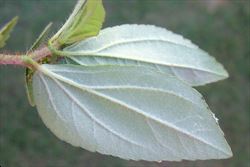
close-up of paler leaf undersides (Photo: Sheldon Navie)

seedling (Photo: Sheldon Navie)
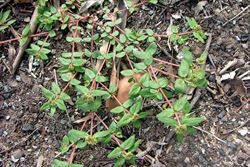
the very similar Chamaesyce ophthalmica, with light green leaves (Photo: Sheldon Navie)
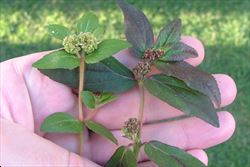
comparison of Chamaesyce ophthalmica, left, with flower clusters only at the tips of the branches, and asthma plant (Chamaesyce hirta), right, with flower clusters in several upper leaf forks (Photo: Sheldon Navie)

the leaves sometimes have purplish markings on their upper surfaces (Photo: Sheldon Navie)
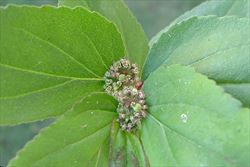
close-up of leaves and young 'flower' clusters (Photo: Sheldon Navie)

dense clusters of 'flowers' in the upper leaf forks (Photo: Sheldon Navie)
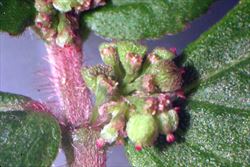
close-up of 'flowers', with hairy ovaries (Photo: Forest and Kim Starr, USGS)
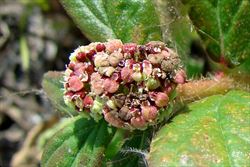
immature and mature fruit (Photo: Forest and Kim Starr, USGS)
Scientific Name
Chamaesyce hirta (L.) Millsp.
Synonyms
Euphorbia hirta L.
Family
Euphorbiaceae
Common Names
asthma plant, asthma weed, asthmaplant, cat's hair, flowery headed spurge, garden spurge, hairy spurge, Jean Roberts, old blood, pill bearing spurge, pill-bearing spurge, pillpod sandmat, pillpod spurge, Queensland asthma weed, red euphorbia, red milkweed, snake weed, snakeweed, sneeze weed, spurge
Origin
This species is widely distributed throughout the topical regions of the world (i.e. pantropical), however it is generally thought to be an early introduction from the Americas into other tropical regions. It is thought to be native to southern USA, Mexico, Central America, the Caribbean and tropical South America (i.e. from Colombia south to northern Argentina).
Because of doubt over the origin of this species, and its probable very early introduction into this country, it is sometimes regarded as being native to northern and eastern Australia.
Naturalised Distribution
Widely naturalised in northern and eastern Australia, but most common and widespread in tropical and sub-tropical regions (i.e. in northern Western Australia, the Northern Territory, Queensland and north-eastern New South Wales). Occasionally also recorded from other parts of New South Wales and in north-western Western Australia. Also naturalised on Christmas Island, the Cocos Islands and Ashmore Reef.
Widely naturalised in the tropical regions of the world, including in south-eastern and eastern Asia (i.e. Vietnam, Thailand, Singapore, Malaysia, Indonesia, Cambodia, the Philippines, Papua New Guinea, China, Taiwan and Japan), Mauritius, New Zealand and on numerous Pacific islands (e.g. American Samoa, Palau, Niue, Nauru, New Caledonia, the Marshall Islands, Kiribati, Hawaii, Guam, French Polynesia, Fiji and the Galápagos Islands).
Notes
Asthma plant (Chamaesyce hirta) is a very widespread introduced plant that is predominantly found in tropical and sub-tropical environments in Australia. It is a common weed of disturbed sites, waste areas, roadsides, gardens, footpaths, lawns, bare areas, crops and pastures. However it also invades natural vegetation, particularly in northern Australia, and is sometimes regarded as an environmental weed in Western Australia, the Northern Territory and northern Queensland.
In Western Australia, where asthma plant (Chamaesyce hirta) often grows along watercourses, it was rated as a moderate priority species in the the state's environmental weed strategy. It has also been recorded in conservation areas in the Northern Territory (e.g. Gregory National Park). In Queensland, asthma plant (Chamaesyce hirta) is a weed of rangelands in the Burdekin region and a weed of highways, roads and powerline corridors in the Wet Tropics World Heritage Area.

